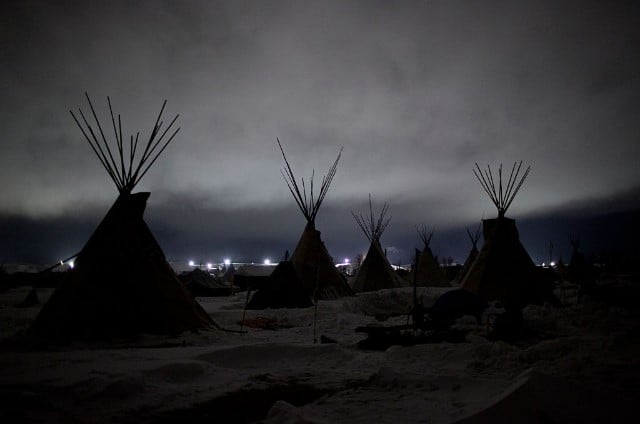
The Trump administration quickly overturned the December 2016 decision by the Army Corps of Engineers to halt the construction of the infamous Dakota Access Pipeline — almost as quickly as Trump took office. Subsequent challenges in court failed to prevent the pipeline from being completed and going into operation. Rather than concede defeat, Water Protectors have shifted their focus and efforts to battling the oil and coal industry on different fronts.
On the Standing Rock Sioux Reservation, the Water Protector camps are no longer standing, but some organizers who lived and organized in those camps are now shaping the movement to shift the reservation away from its dependence on fossil fuels and toward renewable energy.
In 1956, the Standing Rock Sioux sued the Army Corps of Engineers and was promised — as part of the settlement over the creation of dams on the Missouri River that stole part of the reservation’s land and resources — free electricity for the reservation. Instead, the reservation pays some of the highest rates for electricity in both North and South Dakota. Some residents pay $1,000 a month in electric bills, even as more than 40 percent of individuals on the reservation live below the poverty line.
In order to alleviate these steep electricity bills and the reservation’s dependence on electric companies charging high rates for usage, the reservation is working toward creating a mandatory renewable energy standard, where, by 2030, 50 percent of North and South Dakota’s energy will come from renewable resources, with a long-term goal of total renewable use. Currently, the majority of electricity in North Dakota is powered by coal.
The Massachusetts Institute of Technology (MIT) Media Lab’s “Disobedience Finalist Award” was given to the Standing Rock Water Protectors in July of 2017. The award is given to responsible, ethical disobedience in US society, and the Water Protectors received a $10,000 cash prize. On their behalf, Phyllis Young, Joseph White Eyes, Jasilyn Charger and LaDonna Bravebull Allard accepted the award. Young and Bravebull Allard called on MIT to develop a partnership to address the issues facing the Standing Rock reservation.
In January 2018, Young, a former council member for the Standing Rock Sioux tribe and the coordinator/organizer for Central Oceti Sakowin camp — the main camp of Water Protectors at Standing Rock — organized an energy summit on the Standing Rock Sioux Reservation attended by several faculty and staff members from Solve MIT, a resource to connect technology innovators with financial partners and other technology experts to implement solutions for specific societal challenges. Shortly after, MIT announced the Solve fellowship with the Oceti Sakowin. Four to six members of the Oceti community will receive grants this year to complete renewable energy projects for the community. Fellows will attend an MIT event in May 2018, and another one in Standing Rock in August 2018.
As Solve MIT begins to identify fellows and projects to help support, the Lakota People’s Law Project, a North Dakota-based legal group dedicated to “efforts to reclaim ancestral lands, and to stop all threats to Lakota land and resources,” identified SuperGreen Solutions, a small renewable energy group in Bismarck, North Dakota, working to increase energy efficiency and propose renewable energy systems using wind and solar power. The company has already assessed two of eight districts in the reservation to come up with specific proposals for implementing new systems for energy efficiency.
“Tens of millions of dollars can be saved by Standing Rock and millions of pounds of carbon prevented from entering the atmosphere,” said Danny Paul Nelson, deputy director of the Lakota People’s Law Project.
“Anything we can do to save these communities’ resources for social welfare and basic living is a huge benefit from a social justice point of view, but the environmental impact is immense too. There is an opportunity here to set an example for the world — not just how to protest the creation of fossil fuel infrastructure, but also in how to create renewable energy infrastructure as a response to being bullied by the oil industry, which is how we interpret what happened with [the movement against the pipeline].”
The Lakota People’s Law Project is pushing for a petition to implement what’s known as a Renewable Portfolio Standard in North and South Dakota, which would mandate a shift in each state to 50 percent renewable energy by 2030. The group is also advocating for other legislation that facilitates the shift toward renewable energy, like the solar access law that would permit residents to install solar energy infrastructure without the burden of regulations preventing them from doing so.
“North and South Dakota have nothing right now in place to facilitate the shift to renewable energy infrastructure. These states are heavily reliant on fossil fuels, even though these other options exist,” says Nelson. He noted that Standing Rock can’t act in isolation, and statewide legislation would help make Standing Rock’s transition easier, as well as elevate awareness of renewable energy throughout North and South Dakota.
“Coal and oil reign supreme in the Dakotas. They have so much power no one even questions them, and people barely even know what solar is. Rather than it being a battle, there is a vacuum of understanding and interest in green energy. Our interest is in stoking vigorous engagement, with Standing Rock providing leadership in making that happen,” he said.
Join us in defending the truth before it’s too late
The future of independent journalism is uncertain, and the consequences of losing it are too grave to ignore. To ensure Truthout remains safe, strong, and free, we need to raise $50,000 in the next 9 days. Every dollar raised goes directly toward the costs of producing news you can trust.
Please give what you can — because by supporting us with a tax-deductible donation, you’re not just preserving a source of news, you’re helping to safeguard what’s left of our democracy.